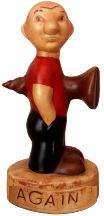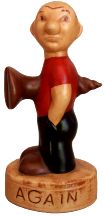 |
 The Virtual Corkscrew Museum's Weekly Newspaper |
 |
 |
 The Virtual Corkscrew Museum's Weekly Newspaper |
 |
|
Sunday, January 21, 2007 |
Helixcle
Vancouver, British Columbia, Canada - With the ice storms of the past week sweeping the United States and Canada, icicles sprouted from trees and building eaves. A very special type of icicle could be found in the Kitsilano residential district of Vancouver. Wayne Meadows grew a "Helixcle" in the back yard of his Corkscrew Inn.
More Whistles
A gallery of Whistle Corkscrews was featured in the January 10 issue. Reader Jens Arnjberg of Denmark submitted these photos of three additional whistles from his collection.
English reader Richard Craven writes "I use this one (above) regularly when working my black Labrador, Barty. The corkscrew comes in handy when we need a break. Barty also comes in when he hears a cork being drawn!"
In SCReWbase we find these whistle corkscrews:
Left: A folding double helix marked S PATT and with the bell trademark of Brookes and Crookes, Sheffield. The double helix is James Wilson's British Patent 898 of March 3, 1877.
Center: A picnic corkscrew marked LB PARIS (Leboullanger 1846-1889).
Right: Wood handle direct pull corkscrew with archimedean worm marked J. J.
Below left: SCReWbase notes that these whistles with carriage key often have an "indistinct diamond registration mark on the head ring". The mark is Joseph and James Hudson's (Birmingham) British Registration 298,209 of February 7, 1876. Compare the locking mechanism and collar to the example shown in January 10 issue (center). A third variation (right) was submitted by Leonard & Debbie McDowell. Note the difference in the corkscrew mount as well as the decoration at the top of the sheath.
Barthel's Whistle
On April 9, 1878 Albrecht Edward Barthel of Detroit, Michigan was granted U. S. Patent Number 202,136 for his "Combined Gun-Tool and Whistle". He wrote "My invention has for its object to combine in a single compact tool for sportmen's use, a dog-whistle, screw-driver, socket-wrench, and shell extractor, with or without the addition of a corkscrew, most of which will be found useful, if not essential in the field."
He further describes the optional corkscrew with "A corkscrew is permanently secured to the inner end of the bulb; but if the sportsman is one of the very few who never thirst in the field, nor become sick enough to require the carrying of a flask of tonic or medicine, it may be omitted."
Higgins' Whistle
Charles L. Higgins of Springfield, Massachusetts applied for his "Match-Box" patent on April 17, 1895. U. S. Patent Number 553,030 was applied on January 14, 1896. In his application Higgins sums up his invention with the claim "A compound pocket implement comprising a match-box made of two tubes longitudinally secured together and provided with a top and bottom, a cigar-cutter in one of said tubes, a cork-screw foldable into the same tube and a call-whistle upon one end of the device."
Nifty Whistle
A whistle corkscrew? Well it doesn't have a whistle but it says "Whistle". It's a Nifty corkscrew with advertising for Whistle Bottling Co., Allentown, Pennsylvania (from the collection of John Stanley).
Corkscrew Palm
Daniel Kissling of Switzerland submitted his photo (left) of a corkscrew palm taken in Zanzibar. His photo was taken with a person standing not so far from the tree to give an idea of scale (the individual is shown in the photo at lower left). Two additional views of the corkscrew palm are at center and right.
|
©2007 Don Bull, Editor |